
Causes of Pain in the Shoulder Joint
By: Prof. Dr. Hermawan Nagar Rasyid, dr., Sp.OT (K)., Ph.D
What often causes shoulder joint pain?
Shoulder pain may arise from the shoulder joint itself or one of the many surrounding muscles, ligaments or tendons. Shoulder pain originates from the joint, and will worsen with increased activity or movement of the arm or shoulder.
Shoulder pain comes from one or more causes, namely:
Overuse (wear/excessive use)
Doing heavy work (hoeing, carrying heavy loads), sports (baseball, archery, golf, lifting weights), using heavy bags causes shoulder pain. Using the shoulder joint too often or hard in the long term causes the soft tissue inside the shoulder to wear out easily resulting in
prone to injury. This is called tendinitis.
Dislokasi

The shoulder is a part of the body that is often dislocated. Dislocation occurs when the bone slips out of the joint socket. For example, the top of the arm bone is attached to the shoulder joint.
The joint head and joint capsule become dislodged or loose, causing the joint head to slip out of the joint. This is due to falling or experiencing a hard blow. It takes a very strong force, such as a sudden blow to the shoulder, to pull the bone out of place. Extreme rotation of the shoulder joint can pop the tip of the upper arm bone out of the
the socket.
Dislocation means the bone is not where it should be, in this emergency situation seek medical help immediately. Untreated dislocations cause damage to ligaments, nerves or blood vessels. Moreover, if the joint has been dislocated, it is more likely to be sprained in the future.
How to deal with shoulder pain?
Depends on the cause of the pain and the symptoms.
First aid for mild shoulder pain involves the RICE method:
- Rest (rest): do not do heavy activities or move the shoulder within 48 hours after the injury.
- Ice (ice compress): apply an ice compress to the injured shoulder for 20 minutes, 4-8 times a day. You can use a plastic bag filled with ice cubes and covered with a towel, or use a ready-made ice compress available at the pharmacy.
- Compression (pressure): gently press the painful area to reduce swelling. The shoulder can be wrapped with a bandage to keep it stable.
- Elevation: keep the injured area higher than the heart. If you want to lie down, support your shoulders with a thick, soft pillow to maintain your position.
Painkillers such as aspirin, ibuprofen, or paracetamol are taken to reduce pain and treat minor injuries or pain caused by frozen shoulder. If symptoms do not improve in a few weeks, get worse, or are severe from the start due to an accident, see a doctor immediately.
The doctor will refer to consult an orthopedic surgeon.
Surgery is necessary to resolve shoulder problems that are severe or recurrent. About 90 percent of shoulder pain patients can improve with simple treatment methods as above.



